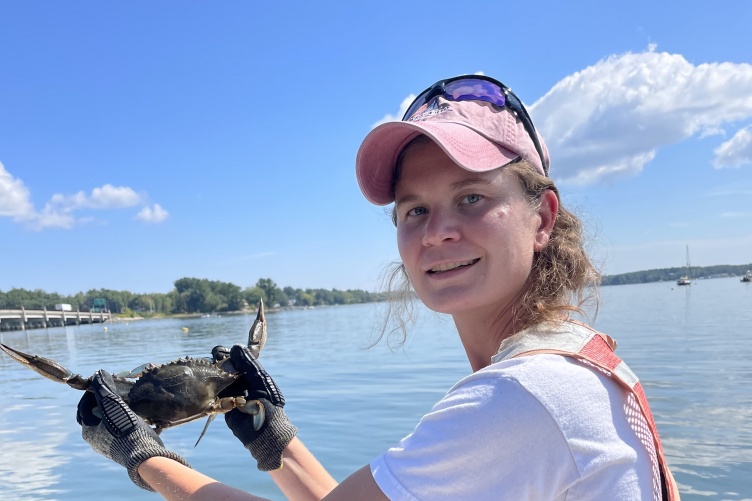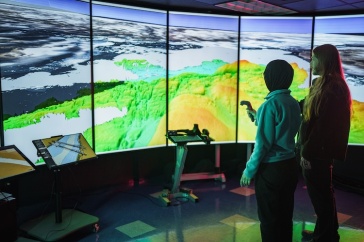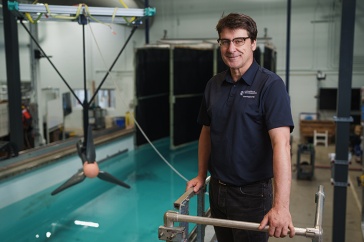
UNH doctoral student Kelsey Meyer with large male blue crab in Great Bay Estuary. Photo by Bonnie Brown.
UNH researchers have scientifically documented the first discovery of a pair of recently mated blue crabs in Great Bay Estuary (GBE) — the official confirmation that conditions in the Bay this year have become hospitable for the species that is typically found farther south. The presence of a breeding population is expected to have serious impacts on the Great Bay ecosystem, although the extent of those impacts is still unknown.
It was a routine late summer day on the estuary checking the traps that had been set out by UNH doctoral candidate Kelsey Meyer to monitor the estuary’s invasive green crab population, when doctoral candidate Alyssa Stasse and technician Emily Williams found a big surprise in one of the traps: two blue crabs that appeared to have mated. The female, which had recently molted, was subsequently examined and found to have distended turgid seminal receptacles with large sperm plugs, clear evidence of crustacean copulation.

Blue crabs have been captured occasionally in GBE since 2012, according to Jason Goldstein ’12G, research director at the Wells National Estuarine Reserve, but this is the first time researchers have found compelling evidence that the crabs are actually mating — and it’s a pretty big deal. It means a species that once only found itself in the colder, less hospitable waters of GBE by accident, has now found the Bay’s waters —warming as the result of climate change — a welcome habitat. Their arrival also heralds significant and potentially devastating implications for the estuary’s ecosystem, particularly its fragile oyster population.
“The arrival of blue crabs capable of creating a sustained population poses a new threat to oysters and other native GBE species,” says Bonnie Brown, professor and chair of the department of biological sciences. Meyer, Stasse and Williams work in Brown’s Ecological Genetics Laboratory.
Continues Brown, “This new predator — which eats bivalves including clams and eastern oysters — brings the possibility of dramatic changes to the GBE ecosystem including how nutrients like nitrogen and phosphorus cycle between the physical environment and living organisms to keep both healthy and thriving. Eastern oyster populations in the Bay provide habitat and nutrient cycling services, and their numbers are estimated to be only about 10 percent of what they were in the 1980s. A breeding population of blue crabs would be really bad news.”
Gabriela Bradt ‘05G, fisheries and aquaculture specialist for New Hampshire Sea Grant and UNH Cooperative Extension, agrees.
"It's exciting from the scientific perspective, but not exciting from the perspective of 'Here's a new species that shouldn't be here.'"
“If [the blue crabs] are here long enough to eat and molt and mate, they may be setting up shop,” she says. “It’s exciting from the scientific perspective, but not exciting from the perspective of ‘Here’s a new species that shouldn’t be here.’”
Bradt is leading a new Great Bay National Estuarine Research Reserve and NH Sea Grant pilot crab monitoring project in GBE to establish a baseline and early detection of several species of concern, including blue crabs, as well as trophic interactions. The project also involves community engagement to begin mapping the distribution of the crabs both locally in New Hampshire and in the region. The team includes Alyson Eberhardt ’04G, ’19G, coastal ecosytems specialist at UNH Cooperative Extension and New Hampshire Sea Grant, Chris Peter ‘07G, research coordinator at the Great Bay National Estuarine Research Reserve (GBNERR), Heather Ballestero, research assistant at GBNERR, and Jessie Batchelder, research assistant at Manomet.
Oysters and the oyster farming industry in GBE are already threatened by invasive green crabs, which also feed on bivalves. Meyer, whose traps caught the two mating blue crabs, is studying the abundance, distribution and diet of green crabs in GBE. She is currently collecting data to gain a better understanding of where green crabs are, when they are there, what are they’re eating and how they interact with Great Bay’s oyster farms.
Brown and her team have submitted the scientific finding of the mated blue crabs to Northeastern Naturalist, a journal that documents natural history of organisms in northeastern North America.
The research projects that both Meyer and Stasse are conducting are funded primarily by a New Hampshire Agricultural Experiment Station Hatch grant, with additional funding from 2022 New Hampshire Sea Grant Graduate Research Fellowships.
-
Written By:
Sarah Schaier | College of Life Sciences and Agriculture


















































